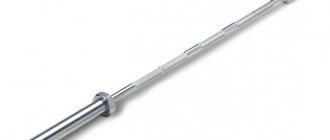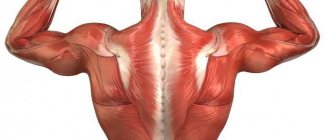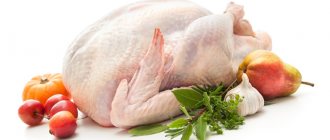Fat or weightlifter?
You can often find a common example in the comparison of fat and muscle: a well-fed person can weigh 100 kg and not look very beautiful, and a bodybuilder who also weighs 100 kg, but has a low percentage of fat, nevertheless looks quite aesthetically pleasing. Same weight, but different shape. In the first case, the person will seem much larger in size than the second, but meanwhile they have the same weight, so what is the mystery?
Having understood the question “Which is heavier: muscles or fat in a person,” everyone can clearly understand what actions they need to take depending on their goal of building a figure. After all, only having certain knowledge in a certain matter can you competently approach solving a problem.
Fat or muscle - which is heavier?
Having understood this topic, you can clearly understand why such dramatic differences in weight and appearance arise. When considering the question “is muscle or fat heavier?” from the point of view of cellular structure, the clear answer is that muscles are heavier, since their cells have a higher density compared to fat cells.
Muscle cells contain protein and water, while fat cells contain only fat, or lipids. You don’t need to have any special knowledge of body structure to understand that protein and water, aka muscles, will be much denser in composition than fat.
Functions of fat deposits
Fat is not a useless phenomenon; its critical level poses a threat to health, so you need to take a responsible approach to the process of losing weight. Layers of fat protect internal organs and create an additional source of heat in cold weather, which explains the decrease in metabolism in winter as the body tries to conserve fat reserves.
Having learned the answer to the question “fat or muscle - which is heavier”, many try in every way to get rid of fat, which exceeds muscle tissue in volume, but it is worth understanding that there is a limit beyond which it is not advisable to go.
The lowest threshold for a woman’s fat level is 12%, after which problems with both appearance and feminine appearance may begin. Men can feel great with 5% body fat.
However, a high percentage of fat is harmful to the body, since the likelihood of developing diabetes increases, energy decreases, metabolism slows down, and lethargy sets in.
Why doesn't the weight change?
Due to the difference in the weight of muscle and fat, when losing weight, your weight may stay the same. In the process of sports activity, both fat is burned and muscle mass is built. Due to the fact that the proportion of body fat may be lower than the proportion of muscle, the effect of stagnant weight change can be created. In other words, two processes occurred simultaneously - fat went away and muscles increased.
Based on this, you should not attach great importance to the numbers on the scales. Visually you can see changes, a decrease in volume in certain areas, but remain at the same weight.
Many people believe that if they work out in the gym, their figure will in any case become athletic, whether they initially have fat or muscles. What is harder - burning lipids or increasing lean mass?
You need to understand that fat does not transfer to muscle. Intense exercise, of course, reduces body fat in a sense, but good results can only be achieved by limiting carbohydrates.
Composition of subcutaneous fat
But why then is the number of calories in subcutaneous fat different?
The reason is simple - subcutaneous fat consists of:
- pure fat;
- connective tissue;
- water;
- other ballast connections.
When calculating fat in foods, water and other compounds that reduce the fat percentage are not taken into account. And when counting calories in subcutaneous fat, this must be taken into account.
Therefore, we find that 1 gram of subcutaneous fat contains only 7.7 calories. But this is still much less than the number of calories in pure fat. It is necessary to remember this information well: the number of calories in subcutaneous fat is lower due to the presence of connective tissue and water, which do not contain calories, and the percentage is correspondingly reduced. And the number 9 is used when calculating the nutritional value of a particular dish.
Therefore, we find that 1 gram of subcutaneous fat contains only 7.7 calories. But this is still much less than the number of calories in pure fat. It is necessary to remember this information well: the number of calories in subcutaneous fat is lower due to the presence of connective tissue and water, which do not contain calories, and accordingly reduce the percentage. And the number 9 is used when calculating the nutritional value of a particular dish.
But why then is the number of calories in subcutaneous fat different?
When calculating fat in foods, water and other compounds that reduce the fat percentage are not taken into account. And when counting calories in subcutaneous fat, this must be taken into account.
Based on this, we find that 1 gram of subcutaneous fat contains only 7.7 calories. But this is still significantly less than the number of calories in pure fat. You need to remember this data well: the number of calories in subcutaneous fat is lower due to the presence of connective tissue and water, which do not contain calories, and accordingly reduce the percentage. And the number 9 is used when calculating the nutritional value of a particular dish.
Heavy bones?
An overweight person has a large proportion of body fat, while the proportion of muscle and bone tissue changes slightly. It is inappropriate to believe that weight can increase due to bone growth, since even a 10% change in the proportion of bone tissue leads to an increase in body weight by only 1-1.5 kg.
You can achieve dramatic weight gain with exercise and proper nutrition, since muscles are heavier than fat and bones. Because of this, the athlete will have large muscle mass and weight, respectively. Although, according to the classification of acceptable parameters and weight, he will belong to the overweight group, while having a low percentage of fat reserves.
Today there is a so-called bioimpedance analysis, which allows you to calculate the percentage of muscle and fat tissue in the body. Based on this, we can conclude whether a person needs to lose weight or gain weight.
When wondering whether fat or muscle is heavier, you need to consider many factors that influence weight gain.
In some cases, for example, during premenstrual syndrome in women or with heart disease, weight may increase due to fluid retention in the body. In this case, you need to consult a doctor. But still, almost everyone is overweight due to excess fat.
When understanding the question “Which is heavier: muscle or fat?”, it is important to pay attention not only to weight, but also to the distribution of fat across parts of the body. Thus, a woman, even if she is overweight, can look harmoniously built, which is due to the uniform distribution of fat deposits throughout the body.
The ratio of hips to waist volumes, taken as the norm, for women is 0.7, for men - 1.
Sample menu for 1000 calories
If you follow a diet for a long time and consume thousands of calories daily, this can lead to metabolic disorders. A reasonable limit for such nutrition is no more than one week.
You need to eat small meals throughout the day. This is in the morning, at lunch, in the evening and two snacks during the day. An example of such a menu:
- For breakfast, eat two tablespoons of low-fat cottage cheese and a slice of rye bread.
- A snack in the form of any one fruit.
- For lunch, half a serving of vegetable soup, leaf salad, 100 grams of boiled chicken and lean buckwheat porridge.
- For an afternoon snack there is also fruit or walnuts (two pieces).
- For dinner you should eat a soft-boiled egg, a vegetable salad, and some lean oatmeal.
- A few hours before bedtime, you can drink a glass of low-fat kefir.
If you asked yourself the question of how many kg are 1000 calories, then most likely you are unhappy with your appearance and want to change your figure for the better. Take advantage of the article’s recommendations on proper weight loss and don’t overdo it!
Everyone knows that it is calculated by the energy released during the digestion of food. At the same time, minerals and vitamins do not contain calories. The main nutritional ingredients that influence a dish are proteins, fats and carbohydrates. Let's talk about this in more detail, and in particular about what the calorie content of proteins is, why the body needs them, and how they should be consumed.
- Kefir kcal per 100 grams
- How much sugar is in 100 grams of beer?
- How many calories are in a gram of protein?
- How many calories are burned when swimming || How many calories are burned when swimming in the pool?
Body types
There are two body types: the female type is “pear” and the male type is “apple”.
People belonging to the first type have a concentration of fat in the buttocks and lower abdomen.
Those in the second type have deposits, usually in the upper part of the body. These people are susceptible to obesity, diabetes, ischemia, and atherosclerosis.
You need to be aware that weight does not play a big role; what this weight consists of is much more important. The same weight of fat and muscle will look different. How? - many will ask. For example, 1 kg of muscle occupies a volume 2 times less than 1 kg of fat.
To replace fat with muscles, you need to eat protein and give up unhealthy foods, then you will no longer worry about the question of what is heavier - muscles or fat in a person.
May 21st, 2014 , 10:00 am
Dedicated to those whose muscles are heavier than fat!
Many people who decide to lose weight correctly, that is, with the help of fitness, often explain the fact that the scales have frozen by saying that muscles are heavier than fat. Allegedly, their weight is due to the fact that when they exercise, they replace fat with muscles that weigh more.
Is it really? Let's figure it out.
After a month in the rocking chair, you begin to look arrogantly at the chickens that keep running to the scales.
You are not like that. You understand that weight loss and fat loss are two different things. Weight loss can occur not only due to fat loss, but also due to the loss of muscle mass, water, and feces.
You robotically repeat that you are “flooded” with PMS and milk, and “the scale arrow is not an indicator, because muscles are heavier than fat.”
Chill out, chickens. The scale arrow is an indicator even for me. Not to mention your flabby asses.
Yes, I really don’t like the question: “Lena, what is your weight?”
For this very reason:
Yes, we have all seen this picture, but only fools understood it this way: “If I go to the gym and my weight stays the same, this means that I am losing fat, and instead I am building muscle, the weight of which is equal to the weight of the lost fat.” .
Such a situation is impossible in principle.
Losing fat is always much easier and faster than gaining muscle mass. Muscles grow very slowly.
Fat also - especially at a certain stage - goes away slowly. And, nevertheless, fat loss and muscle gain are incomparable in their speed. Muscle growth in both women and men always occurs slower than fat loss. In women it is twice as slow as in men.
A woman who is not new to the gym and who trains there conscientiously can gain about 50 grams of muscle mass per week. And this is an excellent indicator.
A healthy person, if he sets a goal to lose weight and does everything right, can easily lose from 500 grams to 1 kg of fat per week.
So if the needle on your scale stays the same for a long period of time (weeks 3-4), this does not mean that by training you are replacing fat tissue with muscle tissue, but that you are unable to lose weight. fat.
Chickens, forget the statement that muscles are heavier than fat, and never try it on yourself. Don't embarrass yourself.
You have no idea how ridiculous it sounds coming out of your mouth, considering that fat loss happens in one way and only one way: when you burn more calories than you consume. With a calorie deficit, there can be no talk of any increase in muscle mass.
Exceptions:
1) Those who have just started to lose weight. This is a matter of the first two weeks, not four or more.
2) Those who use steroids.
If you're working out and the weight isn't coming off, you're probably just eating too much. Even if you exercise a lot, you eat even more. That's why your weight doesn't move.
Do you want a beautiful body? Be smart. Use your head, and don’t replicate misinterpreted truths by flapping your wings.
An excess amount of adipose tissue in the body of any person not only makes his figure unaesthetic, but also threatens with dangerous diseases. Our article today is not about this, but about the ratio of muscle mass and fat. You've probably heard the statement that muscle is heavier than fat. This is true, but there is not such a huge difference between the volumes of fat and muscle, as is usually shown in photographs and pictures.
So, we will help you thoroughly understand what is heavier - muscles or fat, we will analyze specific numbers and tell you how voluminous fat mass is replaced by heavier muscles.
How to increase your calorie expenditure
To increase your calorie expenditure, you need to understand where you spend the most energy. Oddly enough, we spend a huge amount of it doing ordinary everyday things. Washing, cleaning and cooking quietly but surely burn our “fuel”, and when we are in a calorie deficit, we use up fat reserves.
If you add some activity to your daily homework, for example, active walks with your child, going to a distant store instead of the nearest one, then your calorie consumption will increase by almost a third!
Without an active lifestyle, weight will come off more slowly, and your body structure will noticeably suffer. It is important to include in your daily routine any activity for which you have time.
And of course, the most effective way to burn calories is to visit the gym. With or without a trainer, you will have a variety of exercise equipment and tools at your disposal. Find a workout that you enjoy and have fun with it. It will not be superfluous to communicate with like-minded people.
Understanding Fat and Muscle Mass
Overweight people who start exercising to lose weight sometimes get upset when they look at the numbers on the scale. At the same time, they don’t understand why the body weight remains the same, but the figure becomes slimmer? Everything is explained very simply. Heavy weight training and cardio exercises to burn fat burn calories, and along with this, an increase in muscle mass occurs. At first, for beginners who take up sports, their muscles grow quite quickly thanks to new physical exercises.
It turns out that muscle tissue grows and the percentage of fat decreases, but at the same time the scale arrow stays the same or even shifts upward. This is due to the fact that a kilogram of muscle is not as voluminous as the same amount of fat. When training regularly, it is better to weigh yourself not every day, but once every 2-4 weeks, but in any case, weight should not be the main criterion for assessing results. Take body measurements once a month and focus on them, and also look at your reflection in the mirror.
Slowly but surely, fat loss and muscle growth will occur, and your body will transform. Muscle is definitely heavier than fat, so two people of the same height and weight can look different if one plays sports and is in good physical shape and the other has a lot of excess fat.
Physical activity for weight loss
The norm of calories that a person should consume is equal to the sum of the products (weight x 9.99 height x 6.25 age x 4.92). Weight is taken in kilograms, age in years, height in centimeters.
After this, women subtract the number 161 from the sum of the products, and men add the number 5 to it.
The resulting figure is the amount of energy that a person should receive during the day, regardless of whether he leads an active lifestyle or spends all his days in front of the TV or computer.
Calculations obtained using the above formulas will give you the number of calories, consuming which you will not lose weight, but also will not gain excess weight. This is your norm.
In order to lose weight, it is permissible to reduce this norm by ten to twenty percent. Even such a small restriction will help a woman lose up to six kilograms of excess weight in one week.
It is difficult to calculate the exact number of calories consumed per day, but it is quite possible. If you have already wondered whether 1000 calories is how many kg, then you are ready to follow your dream.
Remember that one teaspoon contains about seven grams of product, and a tablespoon contains about fifteen grams. One faceted glass is 250 ml or mg.
At the end of the day, write down in a notebook everything you ate and drank during the day. Take a chart of calorie counts for a variety of foods and drinks and calculate how many calories you have consumed. If the resulting figure is greater than what is needed for weight loss, then the next day reduce your diet by as much as necessary.
Many people wonder how much they need to jump to burn 1000 calories. Let's figure this out.
Jumping rope is the most effective way to burn calories. On average, a person weighing 75 kilograms burns 980 kcal per hour while jumping rope.
During any physical activity, muscle mass will be trained, which is responsible for burning fat deposits. Therefore, for example, even minor fitness activities have a positive effect on your figure.
In order to achieve an ideal figure, you need to perform workouts regularly for one month or even longer. Initially, you will feel aching pain in your muscles, but proper warm-up and continued exercise will put everything in its place.
How long do you need to run to burn 1000 calories? The calculation is carried out not in the number of meters covered, but in the running time. The faster you run, the more calories you will burn. On average, we can say that you can burn 1000 kcal/hour when running up the stairs.
Why is muscle heavier than fat?
How much heavier muscle is than fat can be determined by its density. There are pictures on the Internet that clearly demonstrate how many times muscle tissue is heavier than fat. Usually this difference is amazing - a kilogram of fat is 4-5 times larger than the same amount of muscle. In fact, everything is greatly exaggerated.
Muscle tissue does weigh more than fat tissue, but not significantly. How much muscle is heavier than fat becomes clear in numbers:
- muscle density - 1.3 g per centimeter;
- The density of fat in the human body is about 0.9 g per centimeter.
Accordingly, fat weighs about one and a half times less than muscle. The difference is noticeable, but not as significant as many people think. So it turns out that if you started training, and the weight according to the scales remains the same, perhaps you are simply building muscle while burning calories. At the same time, body volumes remain almost unchanged or even decrease.
Because muscle weighs more than fat, women and men lose their figures over the years if they don't exercise. The fact is that the body weight of 45-50 years old may be the same as at 20-25 years old, but the build will be radically different. In youth, muscles predominate, and over the years, adipose tissue begins to grow, and it is always more difficult for mature people to burn fat.
Many people are mistaken that proper training can turn fat into muscle. This is a grave mistake. The fact is that fat and muscle are built in the body according to completely different principles. When playing sports, the level of fat gradually decreases, and muscles grow - these are two separate physiological processes, since the tissues have a different structure and structure.
Physical activity for weight loss
The calculator for calculating calories for weight loss in this case will be slightly different. The bottom line is that the resulting energy from the first formula should be multiplied by a coefficient that corresponds to your lifestyle. The following coefficients are distinguished:
- 1.2 – sport is completely absent. You replaced it with a sedentary lifestyle.
- 1.5 – there is also no sport, but due to life circumstances you walk a lot or do household chores that require energy expenditure.
- 1.6 – if you add several fitness classes per week to the previous point. For example, three times for an hour a day.
- 1.75 – in everyday life you do not lead an active lifestyle, but do intensive physical exercise for seven hours a week.
- 1.8 – you are active in everyday life plus you spend six to seven hours a week on physical activity.
- From 1.9 and above - you are an athlete, and your life is closely connected with constant physical activity.
When wondering if you burn 1000 calories, how many kg of weight will you lose, do not forget that a sharp decrease in energy value and constant physical activity can lead to irreversible reactions in the body. He will get used to it and stop eating, and you will inevitably begin to lose weight, and it will no longer be healthy thinness.
How are fat and muscle redistributed?
To the question of how much heavier muscles are than fat in the human body, we answered you in detail, but to complete the picture, let’s look at the redistribution of these tissues in the body. It is impossible to say exactly how much muscle and fat should be in the body of a man or woman. Every body contains an amount of water, and people have different lifestyles and metabolisms. Be that as it may, a thick layer of fat is not necessary, but a deficiency of fat is also harmful. Moreover, a low percentage of body fat is especially dangerous for women.
A mistake is made by people who go on low-calorie mono-diets without exercising. The body begins to destroy muscles on its own, since it is the muscles that consume calories. It turns out that the smaller the muscles, the fewer calories are needed for their work. When the diet is completed, the body will return to its original weight, but this will be achieved by storing body fat rather than muscle. Muscles simply cannot grow without exercise.
Since fat weighs lighter than muscle tissue, after some time after the diet you may notice the opposite effect: your body will gain weight, and your figure will become even less attractive! Walking or even jogging in the park will not correct the situation, since the body needs muscles to burn fat. Only proper strength training can pump them up.
May 21st, 2014 , 10:00 am
Many people who decide to lose weight correctly, that is, with the help of fitness, often explain the fact that the scales have frozen by saying that muscles are heavier than fat. Allegedly, their weight is due to the fact that when they exercise, they replace fat with muscles that weigh more.
Pay attention not only to what you eat, but also how much you eat. Likewise, you can easily pack on an unwanted pound by regularly overeating—even small amounts. Determine how many calories you need based on your goals and stick to it. If you want to burn fat, losing 1 to 2 pounds per week is a safe bet.
Fat or weightlifter?
Get your heart rate up with daily cardio to burn calories and speed up fat loss. The American College of Sports Medicine recommends that adults get at least 150 minutes of cardio each week. Try different exercises such as running, cycling, fitness classes and machines at the gym to keep your workouts interesting and help you avoid plateaus. You should also mix it up, rotating between long, steady-state workouts and short, intense interval sessions.
Is it really? Let's figure it out.
After a month in the rocking chair, you begin to look arrogantly at the chickens that keep running to the scales.
You are not like that. You understand that weight loss and fat loss are two different things. Weight loss can occur not only due to fat loss, but also due to the loss of muscle mass, water, and feces.
If you want to build muscles, put down the pink dumbbells and start working out. Women don't have the hormones to create big, strong muscles, so lift heavier than you're used to so you don't look like the Hulk. Three to five sets of eight to 12 repetitions is the general standard for muscle hypertrophy. However, this doesn't mean you shouldn't integrate high-reflective, low-power, low-reactive, high-weight kits. No matter how many reps you do, make sure you use enough weight to make the last couple of reps difficult.
You robotically repeat that you are “flooded” with PMS and milk, and “the scale arrow is not an indicator, because muscles are heavier than fat.”
Chill out, chickens. The scale arrow is an indicator even for me. Not to mention your flabby asses.
Yes, I really don’t like the question: “Lena, what is your weight?”
For this very reason:
If you finish a set and can get five more reps out, you won't be using enough weight. If you're not seeing the results you want, having a log is a useful tool for discovering where you need to make changes. It's also useful for tracking progress when you're trying to improve your muscle-to-fat ratio. Use progress pictures, body fat percentage or body circumference measurements to document changes. However, try not to rely on the scale as a measurement. Your weight does not reflect changes in body composition and can be misleading.
- Record your diet and workouts.
- It can be easy to lose track if you don't write everything down.
Body Composition Analysis provides a detailed report with over 40 data findings relevant to your body.
Yes, we have all seen this picture, but only fools understood it this way: “If I go to the gym and my weight stays the same, this means that I am losing fat, and instead I am building muscle, the weight of which is equal to the weight of the lost fat.” .
Such a situation is impossible in principle.
Losing fat is always much easier and faster than gaining muscle mass. Muscles grow very slowly.
Below is a guide to understand your results. Please note: Each time you book a custom order, you will receive a detailed explanation of your results. During your first analysis, you will also receive comprehensive interpretation guidance.
Protein is made up of nitrogen. High levels of nitrogen in your body's cells indicate good levels of muscle mass and overall health. Low protein levels imply low levels of muscle mass and may indicate poor nutrition and malnutrition.
Why doesn't the weight change?
Minerals. Mineral analysis consists of two groups of minerals: commercial and non-commercial. Calculations used for body composition analysis table. The mineral content is found in the lower right corner of the report under Study Options. Mass is the sum of total body water, protein, minerals, and body weight.
- Soft material mass is the sum of your full body.
- Water, proteins and uncomplicated minerals.
- Note.
Body fat mass is shown in kilograms and represents the amount of fat in your body.
Fat also - especially at a certain stage - goes away slowly. And, nevertheless, fat loss and muscle gain are incomparable in their speed. Muscle growth in both women and men always occurs slower than fat loss. In women it is twice as slow as in men.
A woman who is not new to the gym and who trains there conscientiously can gain about 50 grams of muscle mass per week. And this is an excellent indicator.
Body fat percentage. This is your body fat percentage, calculated by your total fat mass divided by your total body mass. The soft dry mass in each core body segment is shown in kilograms and as a percentage of your actual weight.
The number at the end of the top bar is the amount of soft lean mass for that body segment in kg. The number at the end of the bottom bar is a percentage of your actual weight. If the bottom bar reaches 100%, it means you have the ideal soft dry mass for your weight.
A healthy person, if he sets a goal to lose weight and does everything right, easily loses from 500 grams to 1 kg of fat per week.
So if the needle on your scale stays the same for a long period of time (weeks 3-4), this does not mean that by training you are replacing fat tissue with muscle tissue, but that you are unable to lose weight. fat.
The ratio of extracellular water to whole body water is an important indicator of whether the body's water is balanced. The more muscle mass, the higher the result will be. It is possible to score over 100 points if you have very high muscle mass. Please note that very low fat mass will lower your score. These are suggestions only and depend on your goals. This section looks at the balance of your upper body, your lower body, and the balance between your upper and lower bodies.
This shows the distribution of fat around the body. This is an individual measurement of the circumference of individual parts of the body. High mineral content usually indicates higher bone density. The main role of this indicator is to help assess the state of your nutrition.
Chickens, forget the statement that muscles are heavier than fat, and never try it on yourself. Don't embarrass yourself.
You have no idea how ridiculous it sounds coming out of your mouth, considering that fat loss happens in one way and only one way: when you burn more calories than you consume. With a calorie deficit, there can be no talk of any increase in muscle mass.
Excessive fat in this area may indicate a hormonal imbalance. Heart rate: The speed at which your heart beats in beats per minute. Please note that we do not share your information with anyone without your permission. Height We use a digital stadiometer to accurately measure height. Your height is automatically imported into the body composition analyzer.
Age and gender. Our technology measures you and only you. Of course, a healthy ratio is 100. Look, we have a huge misconception that metabolism is nothing more than a calorie burner, and that weight loss is a matter of burning calories, which can come from body fat, muscle, or even bone masses. While your body can catabolize muscle under extreme circumstances, this is not a normal occurrence, even with weight loss.
Exceptions:
1) Those who have just started to lose weight. This is a matter of the first two weeks, not four or more.
2) Those who use steroids.
If you're working out and the weight isn't coming off, you're probably just eating too much. Even if you exercise a lot, you eat even more. That's why your weight doesn't move.
Do you want a beautiful body? Be smart. Use your head, and don’t replicate misinterpreted truths by flapping your wings.
Your metabolism does not “burn calories.” Metabolism consists of two complex processes; catabolism, which separates your food into its smallest usable parts, and anabolism, which reassembles these parts into the cellular structures required by your body. Your metabolism then maintains these cells and replaces them on a regular schedule.
You can easily understand that in order for the nutrients from your food to be available for this constant building process, your food doesn't end up being burned for energy, right? Energy management is only a tiny part of what metabolism does and only uses a small portion of your food, with most of your food being converted into raw materials for this ongoing internal building project.
The fact is that muscle, by definition, is heavier than fat and this is due to the cellular structure. Chickens, forget the statement that muscles are heavier than fat, and never try it on yourself. If you put 1 kg of fat on one scale and 1 kg of muscle on the other, the scales will be equal. You robotically repeat that you are “flooded” with PMS and milk, and “the scale arrow is not an indicator, because muscles are heavier than fat.” Losing fat is always much easier and faster than gaining muscle mass. Muscles grow very slowly.
Now here's a little secret about your metabolism that puts everything into perspective. If your metabolism is provided with everything it needs to do its amazing and beautiful job of building, repairing and maintaining you, then it does a wonderful job of discarding the excess unnecessary material as waste. Thus, excess body fat is mainly caused by either complete malnutrition or a terrible imbalance of species and nutrients.
Well, muscles are neither redundant nor unnecessary. So, once you provide your body with the nutritional balance it will throw away? Your metabolism is perfectly designed to keep you in optimal health and fitness as long as you do your part and provide what it needs. It's not going to catabolize muscle without a good reason.
Many people who decide to lose weight correctly, that is, with the help of fitness, often explain the fact that the scales have frozen by saying that muscles are heavier than fat. Allegedly, their weight is due to the fact that when they exercise, they replace fat with muscles that weigh more. Is it really? Let's figure it out. Chill out, chickens.
However, there are two caveats here. The second caveat is this: if you are overweight, you probably have fat tissue mixed with your muscle tissue. Have you ever had a nice, juicy, well-marbled steak? This marble is fat mixed with muscle. Cattle are fattened precisely for this purpose. The same thing happens with people; fat mixes with muscle. So when you lose fat from muscle, your muscles may appear smaller and perhaps even saggy. But you haven't lost muscle, just muscle fat.
Toning exercises and moderate weights will fix this in no time. Does all this make sense to you? Eat right; include foods that provide a full range of 93 nutrients in proper balance, eliminate factory-processed junk food and drink, and get plenty of water. You do this and your metabolism will literally shed excess fat as waste and keep your muscles intact.
Such a situation is impossible in principle. Fat also - especially at a certain stage - goes away slowly. And, nevertheless, fat loss and muscle gain are incomparable in their speed. Muscle growth in both women and men always occurs slower than fat loss. In women it is twice as slow as in men. A woman who is not new to the gym and who trains there conscientiously can gain about 50 grams of muscle mass per week. And this is an excellent indicator.
If you want to effectively lose fat, you need to learn how to calculate the calories needed to achieve your fat loss goals. Counting calories is just one small piece of the puzzle. When you're ready to be incredible in your diet and improve your body composition, you'll also want to be in tune with your macronutrient breakdown. This post provides five simple steps to calculate your macros to lose fat.
This is part 3 of a 3-part series. Then move on to Part 2 of 3, where you'll learn the basic principles of losing fat while improving your body composition. This article, combined with the two posts above, will equip you with the tools you need to take your fat loss to the next level and get closer to a leaner, more sculpted physique.
Why does volume decrease and weight increase? What's heavier: fat or muscle?
You have no idea how ridiculous it sounds coming out of your mouth, considering that fat loss happens in one way and only one way: when you burn more calories than you consume. 1) Those who have just started to lose weight. This is a matter of the first two weeks, not four or more. 2) Those who use steroids. If you're working out and the weight isn't coming off, you're probably just eating too much. Even if you exercise a lot, you eat even more.
In the next five steps, you'll learn how to figure out your macros for fat loss. There will be some basic math and it can get confusing, so grab a pencil and paper. Write down your numbers and you'll be well on your way to understanding and using a highly effective method for pain relief.
Step 2 - Calculate Protein Requirements for Fat Loss
Step 1 - Calculate your total daily energy expenditure for fat loss and creating a calorie deficit.
When calculating your macros to lose fat, the first macronutrient we should look at is protein. The reason we need to focus on protein first.
How to lose these calories?
In order to lose a certain amount of pounds and kilograms, you need to achieve a daily calorie deficit of approximately 500 calories.
A calorie deficit is the difference between the amount you eat and the amount you burn. Under these conditions, you can lose about 1 pound per week (times 7 days), and after 2 weeks you will have lost 1 pound of fat. It’s easy to calculate that with a deficit of 1000 calories every day, the time frame for losing 1 kilogram will be reduced to 1 week.
A calorie deficit is the difference between the amount you eat and the amount you burn. Under these conditions, you can lose about 1 pound per week (times 7 days), and after 2 weeks you will have lost 1 pound of fat. It’s easy to calculate that with a deficit of 1000 calories every day, the time frame for losing 1 kilogram will be reduced to 1 week.
Dedicated to those whose muscles are heavier than fat!
This will undoubtedly happen. But here’s the question: why is it that when you play sports and stick to a diet, your weight not only stays the same, but sometimes even increases? Why does this happen, because it would seem more logical to lose weight through diet and fitness, but the weight increases? Some explain this by an error in the scales or excessive retained liquid. The fact is that diet and exercise can burn fat. Meanwhile, sport helps build muscle mass, making the body beautiful, sculpted and toned.
The easiest way to determine your protein needs if you don't have a way to measure your body fat percentage is to consume 1 gram of protein per pound of body weight. If you are overweight or obese, it is better to use 1 g of protein per kilogram of body weight. This requires you to measure your body fat percentage.
Since 1 g of protein contains four calories, 105 g of protein is 420 calories. 30% is a good start as a baseline that you can adjust later. For accelerated fat loss or those who train and exercise intensely, you may benefit from consuming about 35% of your calories in protein because it has been shown to be the most satiating of all macronutrients, which can be helpful when you are on a limited diet. number of calories to make you feel fuller. Protein is also the most expensive substrate to metabolize, meaning it has the highest thermic effect of all macronutrients.
But muscle weighs more than fat mass. They are heavier, and therefore the scales may not change their readings and even give weight gain. The difference is in volume! 1 kg of muscle will look a little larger in size than a tennis ball. 1 kg of fat will be 3 times larger and look like a jellyfish. I was inspired to write this article by people’s questions regarding weight that stands still and does not want to go anywhere, while people strive to get rid of excess weight and make every possible effort to burn fat. What is the mystery of this phenomenon?
How to get ripped muscles - in a nutshell
Properties of human fat
There is an opinion that the number of fat cells in the body is determined by a hereditary factor, such as eye or hair color. However, there is other information that refutes this opinion, and it lies in the fact that the number of fat cells in a child is determined by how the mother ate. It also became known that in obesity, fat cells can divide on their own, and then only surgical intervention can help overcome them.
Fat in the body is divided into several types: brown, subcutaneous and internal
. The brown type of fat is needed so that the body can maintain the correct temperature. There is enough such fat in the body of infants - it protects them from hypothermia. Subcutaneous fat, as its name implies, is located directly under the skin and is the familiar cellulite. This is exactly the type of fat that we constantly struggle with. As for internal or visceral fat, it is deposited on the surface of human organs and inside them. Fat can grow into muscle tissue and even penetrate into the heart.
Together with the blood, excess fat circulates through the vessels, clogs them, and is deposited on the wall. It becomes difficult for blood to penetrate the body's cells, blood pressure rises, and possible malaise. Cholesterol plaques cause stroke and heart attack. Therefore, it is important to get rid of not only the fat that is visible to the naked eye, but also to free the internal organs from it. Despite the fact that the effects of different types of fat are different, their calorie content remains the same.
What does body weight consist of and what is the ratio of the weight of fat, muscle and bone?
In simple terms, muscle cells contain proteins and water. and in fat cells, oddly enough, there are fats. These fats are called lipids. Proteins in water (muscles) are much denser in structure than the above lipids (fats). It is also important to understand that weight stagnation or even gaining extra pounds may be associated with the specifics of your diet. If you exercise regularly and your diet is dominated by protein foods, then it is possible that muscle volume has increased and the percentage of body fat has decreased.
So how many kilograms are in this cherished figure?
Without a doubt, a person's weight and the calories they consume are related. We constantly eat to maintain our vitality. As a result of this, our body weight can either increase or, conversely, decrease. It all depends on the amount of energy consumed with food, which is expressed in calories.
In order to lose one kilogram of weight, you need to burn seven thousand calories. Therefore, after making simple calculations (1000 grams * 1000 calories / 7000 calories), we can come to the conclusion that a thousand calories is 143 grams. And 1000 calories is how many kg? The answer to this question is this: if you lose a thousand kilocalories, then you will lose one-seventh of a kilogram.











